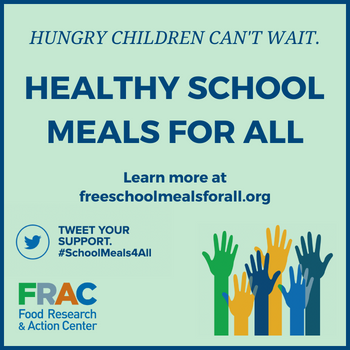School lunch is critical to student health and well-being, especially for children from low-income households—and ensures that students have nutrition they need throughout the day to learn. Research shows that receiving free or reduced-price school lunches reduces food insecurity, obesity rates, and poor health. In addition, the new school meal nutrition standards are having a positive impact on student food selection and consumption, especially for fruits and vegetables.
Quick Facts
- Reimbursable meals must meet federal nutrition standards that are based on the Dietary Guidelines for Americans. National School Lunch Program lunches provide one-third or more of the recommended levels for key nutrients.
- Research shows that school meals are the most nutritious meals that American children receive. Children who consume school meals have higher intakes of milk, fruits, and vegetables, and lower intakes of snacks and desserts, compared to non-participants.
- USDA’s latest nutrition standards, which are being phased in gradually starting in the 2024-2025 school year, by strengthening requirements for added sugars and sodium.
School Lunch Participation:
- Reduces Food Insecurity
- According to one estimate using national data, receiving free or reduced-price school lunches reduces food insecurity by at least 3.8 percent.
- Among a sample of children from low-income households entering kindergarten, receiving a free or reduced-price school lunch reduces the probability of household food insecurity at school entry, whereas paying full price for school lunch is associated with a higher probability of household food insecurity.
- Rates of food insecurity among children are higher in the summer — a time when many do not have access to the good nutrition provided by the school meal programs available during the academic year.
- Improves Dietary Intake
- Children participating in school meals are less likely to have nutrient inadequacies and are more likely to consume fruit, vegetables, and milk at breakfast and lunch.
- Students from low-income households who eat both school breakfast and lunch have significantly better overall diet quality than comparable students who do not eat school meals.
- School meal nutrition standards are having a positive impact on student food selection and consumption, especially for fruits and vegetables.
- Packed lunches brought from home by pre-kindergarten and kindergarten students have more calories, fat, saturated fat, and sugar than school lunches, and less protein, fiber, vitamin A, and calcium, according to a study conducted after implementation of the new school meal nutrition standards.
- Few packed lunches and snacks brought from home meet National School Lunch Program standards.
- Positively Impacts Health
- Participation in federally-funded child nutrition programs is associated with a significantly lower body mass index (BMI) among young children from low-income households. These findings lead researchers to conclude that “subsidized meals at school or day care are beneficial for children’s weight status, and we argue that expanding access to subsidized meals may be the most effective tool to use in combating obesity in poor children.”
- Based on national data, economists estimate that the receipt of a free or reduced-price school lunch reduces obesity rates by at least 17 percent.
- Receiving free or reduced-price school lunches reduces poor health by at least 29 percent based on estimates using national data.
- Meeting Children’s Nutritional Needs Leads to a Better Learning Environment
- Behavioral, emotional, and mental health, and academic problems are more prevalent among children and adolescents struggling with hunger.
- Children and adolescents experiencing hunger have lower math scores and poorer grades.
- Children experiencing hunger are more likely to be hyperactive, absent, and tardy, in addition to having behavioral and attention problems more often than other children.
- Teens experiencing hunger are more likely to have been suspended from school and have difficulty getting along with other children.
- Children with hunger are more likely to have repeated a grade, received special education services, or received mental health counseling, than children from low-income households who do not experience hunger.

Research Brief Shows That School Breakfast and Lunch Programs Continue to Have Multiple Positive Effects on Students’ Health, Learning, and Well-Being
School Meals are Essential for Student Health and Learning reviews the many benefits of the school meals programs, and summarizes the latest research on recent policy changes and innovative strategies that are increasing program access and improving student outcomes.

